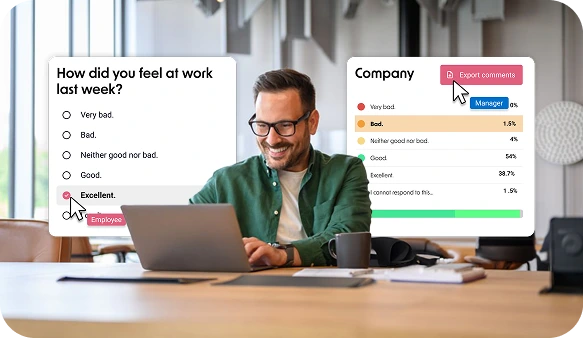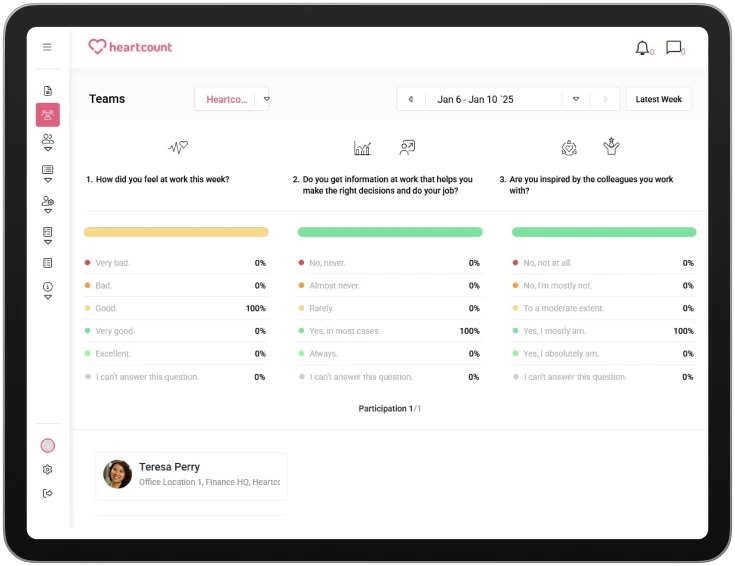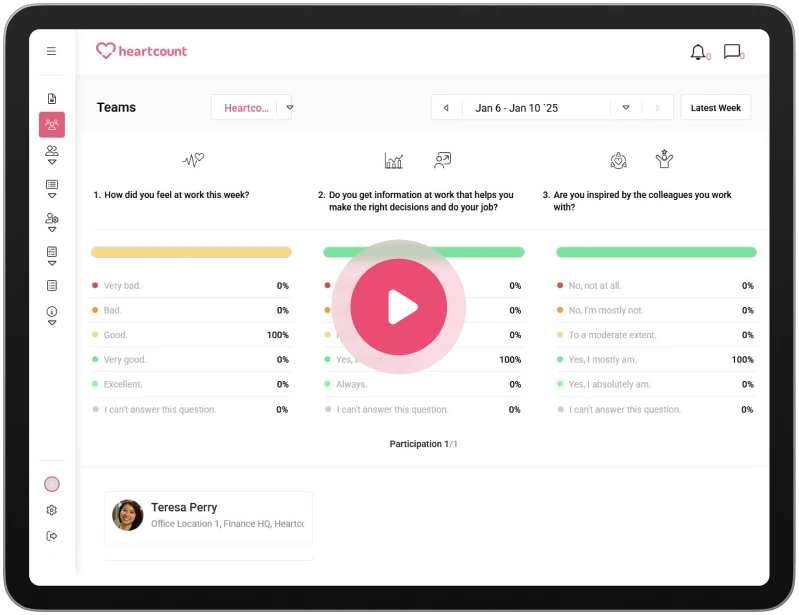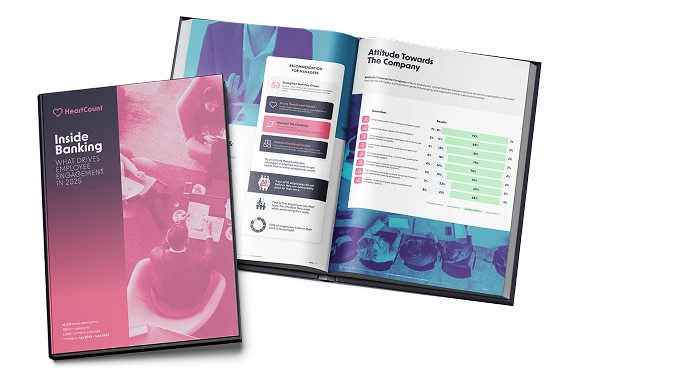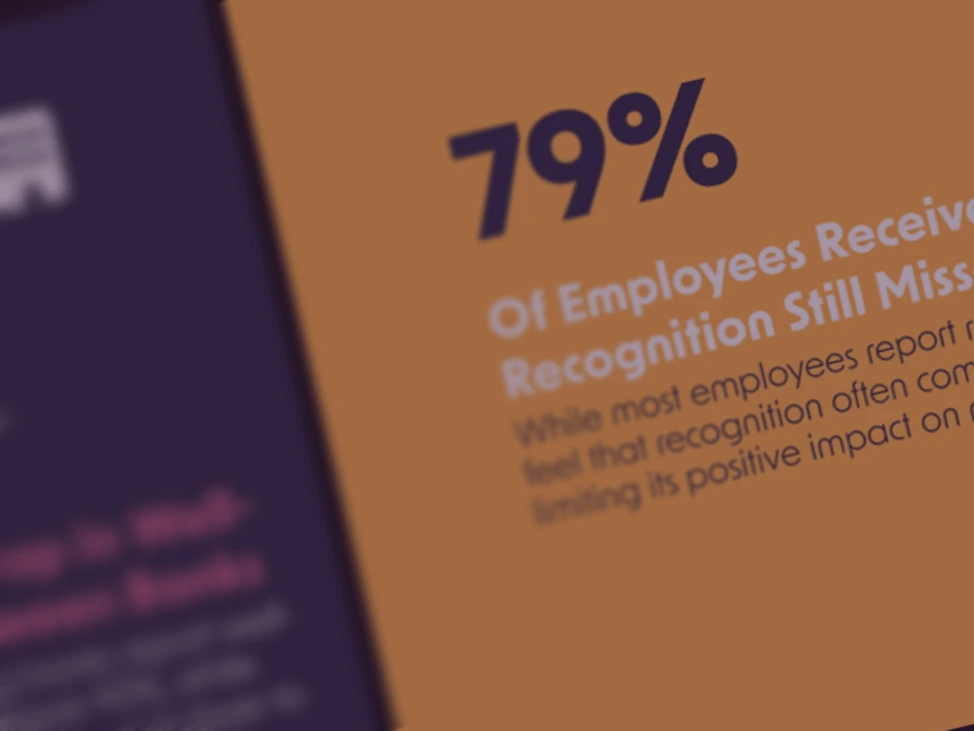One-on-One Questions for Employees: 60 Examples Every Manager Can Use

One-on-one meeting questions are a powerful lever for engagement, yet managers often overlook them in favor of task-driven check-ins. A report from the Harvard Business Review, based on data from Microsoft’s Workplace Analytics team, found that employees who have twice as many one-on-ones with their managers as their peers are 67% less likely to be disengaged, while those with little to no one-on-one time become significantly more disconnected.
This guide is designed to help you harness that engagement opportunity with 60 carefully grouped questions to elevate your one-on-ones. We’ll also share structure, mindset, and tool-based strategies, including how HeartCount can turn those conversations into clear data insights, real-time sentiment tracking, and follow-up action.
-
1.Why One-on-One Meetings Matter for Managers
-
2.What Holds Managers Back From Great One-on-Ones?
-
3.How to Prepare for a Productive One-on-One
-
4.60 One-on-One Questions for Managers to Ask Employees
-
5.Encouraging Two-Way Dialogue in Your One-on-Ones
-
6.Templates and Tools for Better One-on-Ones
-
7.Frequently Asked Questions about One-on-one Meetings
-
8.Build Stronger Teams Through Better One-on-Ones
One-on-one meeting questions are a powerful lever for engagement, yet managers often overlook them in favor of task-driven check-ins. A report from the Harvard Business Review, based on data from Microsoft’s Workplace Analytics team, found that employees who have twice as many one-on-ones with their managers as their peers are 67% less likely to be disengaged, while those with little to no one-on-one time become significantly more disconnected.
This guide is designed to help you harness that engagement opportunity with 60 carefully grouped questions to elevate your one-on-ones. We’ll also share structure, mindset, and tool-based strategies, including how HeartCount can turn those conversations into clear data insights, real-time sentiment tracking, and follow-up action.
Why One-on-One Meetings Matter for Managers
From Retention to Culture: What the Data Tells Us
One-on-one meetings are one of the most effective and underused tools in a manager’s toolkit. When held consistently and with purpose, they can significantly improve employee engagement and retention.
Beyond just feeling heard, employees with regular one-on-ones tend to stay longer and contribute more actively to team culture. These meetings provide a space to flag blockers early, celebrate small wins, and ensure that personal goals are aligned with broader team objectives. If you’re working to improve employee retention, this simple practice is often where meaningful change begins.
One-on-ones are also a powerful lever for shaping culture on a human level. Rather than waiting for an annual survey or formal performance review, managers can use short, focused check-ins to strengthen trust and resolve issues before they escalate. As covered in our article on the benefits of employee engagement, even small signals of attentiveness from a manager can ripple out into stronger teams and better business outcomes.
One-on-Ones vs. Traditional Check-Ins: What’s the Difference?
It’s easy to mistake one-on-ones for status updates or quarterly reviews, but their purpose is much broader. A traditional check-in often focuses on what is being done, while a well-run one-on-one explores how the person behind the work is feeling, coping, and growing.
One-on-one meetings should be personalized, reflective, and forward-looking. They offer a private space for employees to bring up blockers, clarify direction, or simply be seen as a whole person. That’s what makes them such a powerful part of modern people management.
Unlike static processes, one-on-ones are adaptable by design. Managers can use them to pulse-check on wellbeing, discuss development goals, or fine-tune workload in real time. When supported by platforms like HeartCount, these conversations become even more impactful by feeding into ongoing feedback loops and sentiment insights that help managers take action, not just listen.
What Holds Managers Back From Great One-on-Ones?
“I don’t want it to feel awkward”
Many managers hesitate to initiate deeper conversations because they fear the meeting will feel forced or uncomfortable. This discomfort is especially common among first-time managers or those who were promoted for technical excellence rather than people skills. But awkwardness often comes from a lack of preparation, not from the meeting itself.
The solution isn’t to avoid these conversations, it’s to normalize them. When employees see that check-ins are a regular and safe space to share what’s working and what’s not, that awkwardness fades. Creating a psychologically safe environment starts with consistency and intention. If managers avoid meaningful dialogue, they risk becoming accidental micromanagers, stepping in only when something breaks. You can read more about how that harms creativity in our blog on micromanagement and growth.
“I don’t know what to ask”
This is one of the most common blockers, especially for managers who are juggling many priorities. The good news? You don’t need to be a coach or therapist to ask good questions, you just need a bit of structure. Having a go-to bank of thoughtful, open-ended prompts can take the pressure off and help guide the conversation.
In fact, asking better questions is often what separates average managers from great ones. It’s easy to fall back on surface-level check-ins like “How’s everything going?” which rarely lead to meaningful answers. This uncertainty is one of the common mistakes that managers make. By preparing a set of thoughtful one-on-one questions, managers can avoid shallow conversations and create a space where employees feel heard and supported.
“We don’t have time for these”
Time is a real constraint, but skipping one-on-ones often leads to bigger problems down the line: misalignment, burnout, attrition. What might seem like a 30-minute task today can prevent a three-month backfill search tomorrow.
If time is tight, shorter check-ins are still better than none. Even 15-minute conversations can keep priorities aligned and build momentum. The key is to protect that space and treat it like a non-negotiable leadership responsibility. One-on-ones aren’t something you make time for when it’s convenient, but how you make your team run better every week.
The following 60 one-on-one questions are grouped by themes to help you turn one on one employee meetings into conversations that build trust, surface insights, and keep teams engaged.
COLLECT
How to Prepare for a Productive One-on-One
Preparing for a meeting is just as important as running it. Managers who come in without a plan of one-on-one questions to ask employees often default to surface-level updates, which leaves employees feeling unheard. A little preparation, thinking through the intention, the tone, and how you’ll follow up, can turn a routine meeting into a powerful conversation that builds trust and drives progress.
Set Intentions, Not Just Agendas
A one-on-one works best when it has a clear purpose. Instead of simply filling time with updates, managers should enter the meeting knowing what they want to achieve, whether it’s checking in on wellbeing, clarifying goals, or identifying blockers. Setting this intention helps guide the flow of conversation and ensures that the meeting feels valuable for both sides.
Build Psychological Safety From the Start
Employees won’t share openly unless they feel safe doing so. That means creating an environment where people know they won’t be judged for voicing concerns, mistakes, or frustrations. A good approach is to start each session with simple, open-ended employee check-in questions. This makes space for honest dialogue and signals that you care about the whole person, not just their output. Over time, consistency in tone and follow-through turns one-on-ones into trusted conversations rather than formal obligations.
Document and Track Progress Over Time
Without follow-up, even the best one-on-one discussions can lose impact. Documenting key points and action items helps keep both manager and employee accountable. This doesn’t have to be a lengthy process, even a few bullet points are enough to keep track of themes, commitments, and progress over time. Tools like data-driven insights make this easier by consolidating feedback, patterns, and trends, so nothing falls through the cracks. The goal is to make one-on-ones a cycle of listening, acting, and revisiting, rather than one-off conversations.
60 One-on-One Questions for Managers to Ask Employees
One-on-one meetings are most impactful when they’re guided by thoughtful, open-ended prompts. Instead of relying on generic “How’s everything going?” questions, managers can use a structured set of themes to uncover what employees need, how they’re progressing, and where support is most valuable. Below you’ll find 60 examples of one-on-one questions, grouped by category so you can adapt them to different situations and employee types.
General Check-In Questions
These questions help open the conversation and set a supportive tone. They work well at the start of a one-on-one, giving employees the chance to share what’s top of mind before moving into performance or goals.
- What’s been the highlight of your week so far?
- Are there any frustrations or challenges weighing on you right now?
- How are you feeling about your current workload?
- What’s one thing that’s been energizing you at work recently?
- Is there anything outside of work that you’d like me to be aware of?
Performance and Goal-Tracking Questions
These prompts help you understand how employees feel about their current performance, where they see progress, and what obstacles might be holding them back. They keep the focus on outcomes and support rather than micromanagement.
- How confident do you feel about your current priorities?
- Which recent achievement are you most proud of?
- What’s been slowing you down or blocking your progress?
- Are there goals you’d like to revisit or clarify?
- How do you see your work contributing to the team’s overall success?
Career Growth and Development Questions
Employees want to know that their manager cares about their long-term development. These one-on-one questions for employees are designed to uncover aspirations, learning opportunities, and ways to support growth.
- What new skills would you like to develop this year?
- Are there stretch projects you’d like to take on?
- How do you feel about your career path here so far?
- What learning opportunities would excite you most right now?
- Are there areas where you’d like more mentorship or guidance?
Feedback-Oriented Questions
Feedback should move in both directions, and using 360-degree feedback as a framework can help managers think more broadly about how to approach these conversations. These questions open the door for employees to share their thoughts and also invite them to receive constructive input.
- Do you feel like you’re getting enough feedback from me on your work?
- What kind of feedback helps you grow the most?
- How do you prefer to receive feedback: immediately, in writing, or during our one-on-ones?
- Are there areas where you’d like more clarity or direction from me?
- Is there anything I could be doing differently to support you better?
Work-Life Balance and Wellbeing Questions
Checking in on whether someone might be an overworked employee should be part of every manager’s routine. These conversations help uncover stress, workload concerns, and opportunities to provide support before they turn into burnout.
- How have your energy levels been lately?
- Do you feel like your workload is manageable right now?
- Are there any tasks or projects that feel overwhelming?
- Do you feel comfortable disconnecting from work when your day ends?
- What’s one thing we could adjust that would make your work-life balance healthier?
Relationship and Trust-Building Questions
Trust is built in small moments, and these questions help managers strengthen the manager–employee relationship beyond project updates.
- What’s something about your work style that you’d like me to understand better?
- Do you feel comfortable raising concerns with me when they come up?
- What motivates you the most at work?
- Are there team relationships you’d like to strengthen?
- Is there anything I can do differently to build more trust with you?
Strategic Alignment and Motivation Questions
These questions make sure employees understand how their work connects to bigger goals and help uncover what keeps them motivated.
- Do you feel clear about the team’s priorities right now?
- How does your current work connect to the company’s mission?
- Are there any goals that feel unclear or unrealistic?
- What motivates you the most about the projects you’re working on?
- Do you see opportunities where we could be more aligned as a team?
Problem-Solving and Innovation Prompts
One-on-ones aren’t just for reflecting, as they’re also a great time to generate new ideas and remove roadblocks.
- What’s a process that could be improved on our team?
- If you had unlimited resources, what’s one change you’d make?
- Is there a recurring obstacle that we haven’t addressed yet?
- How can I help remove barriers that are slowing you down?
- What’s one idea you’ve been thinking about that we haven’t discussed yet?
Tailored Questions by Employee Type
Different employees need different kinds of support. These questions can be adapted depending on whether you’re meeting with a new hire, a high performer, a long-tenured employee, or someone working remotely.
For New Hires
- What’s been most surprising since you joined?
- Is there anything that still feels unclear about your role?
- Do you feel you have the resources and support you need to succeed?
- What’s been the most helpful part of onboarding so far?
- Is there a skill or tool you’d like more training on right now?
For High Performers Seeking Growth
- What’s the next challenge you’d like to take on?
- Are there leadership opportunities you’d like to explore?
- Which parts of your work feel most energizing to you?
- Are there areas outside your current role where you’d like to contribute?
- How can I best advocate for your growth within the company?
For Long-Tenured Team Members
- What’s one thing you’d like to see change in the way we work as a team?
- Do you feel your experience here is being used to its full potential?
- Are there traditions or processes that you think we should preserve?
- How do you keep yourself motivated after being here for so long?
- Is there knowledge you’d like to pass on to newer colleagues?
For Remote or Hybrid Employees
- Do you feel included in team conversations and decisions?
- What can I do to make remote collaboration easier for you?
- Are there times you’ve felt disconnected from the team?
- Which communication tools are most effective for you day-to-day?
- How can we make virtual meetings more valuable for you?
Encouraging Two-Way Dialogue in Your One-on-Ones
Creating space for two-way dialogue is essential. In fact, a survey found that 65% of employees want more feedback from their managers, yet many also wish for the chance to give feedback in return. That’s why effective one-on-ones should not only cover questions from managers but also invite input from employees and empower them to lead parts of the conversation.
How to Invite Feedback About Your Own Management Style
One-on-ones aren’t only for managers to ask questions. They should also give employees a safe space to share how they experience your leadership. A simple check-in like “What’s one thing I could do differently to support you better?” can open the door to honest feedback. The key is to listen without getting defensive.
Thank employees for their input, act on what you can, and circle back in the next meeting to show you took it seriously. Over time, this builds trust and models the kind of openness you want to see across your team.
Empowering Employees to Own the Conversation
Managers often feel responsible for filling the agenda, but the most effective one-on-ones are those where employees take the lead. You can encourage this by keeping a shared document where they can add topics in advance, or by asking, “What’s the most important thing we should talk about today?”
This helps shift the meeting from a manager-led check-in to a collaborative space. When employees feel ownership, they’re more likely to surface what really matters, from personal blockers to bold new ideas.
UNDERSTAND
Templates and Tools for Better One-on-Ones
One-on-One Meeting Agenda Template
Having a clear structure keeps one-on-ones focused and valuable. A simple agenda might include a personal check-in, progress updates, discussion of roadblocks, and time for career or development topics. Keeping this consistent ensures nothing important gets missed.
Below is a simple agenda template you can adapt to your team:
One-on-One Agenda Template (30–45 minutes)
| Time | Agenda Item | Example Prompts |
|---|---|---|
| 5 min | Personal Check-In | How are you feeling this week?Is there anything outside of work you’d like me to be aware of? |
| 10 min | Progress and Updates | What’s going well with your current projects?Are there any blockers or challenges? |
| 5–10 min | Feedback Exchange | Do you feel like you’re getting enough feedback?What feedback do you have for me? |
| 5–10 min | Career and Development | Are there skills or projects you’d like to explore?How can I support your long-term growth? |
| 5 min | Wrap-Up and Next Steps | What are our key takeaways?What actions should we follow up on? |
To make implementation easier, managers can keep notes in a shared document or use tools like employee overviews to track themes, feedback, and progress over time. This helps ensure every conversation connects back to ongoing support.
Pulse Survey Questions to Track Manager Impact
One-on-ones are powerful, but they’re even stronger when paired with continuous feedback. Running quick check-in surveys can reveal whether employees feel supported, if communication is clear, and how team sentiment is shifting over time. With automated employee pulse surveys, managers get real-time insights into how their one-on-ones are landing and where to adjust.
Using HeartCount to Close the Feedback Loop
The most important part of a one-on-one is what happens afterward. Employees need to see that their input turns into action. HeartCount makes this easier by capturing feedback, spotting trends, and prompting managers to follow up. By connecting conversations to measurable outcomes, managers ensure one-on-ones don’t stop at good intentions but lead to stronger engagement and real progress. Learn more about building a consistent feedback loop that supports ongoing dialogue.
Frequently Asked Questions about One-on-one Meetings
How often should managers have one-on-ones?
Weekly or biweekly meetings tend to work best. The key is consistency, as employees are more engaged when they know they have a regular space to talk. New hires or employees going through transitions may benefit from more frequent sessions.
What should a manager never say in a one-on-one?
Avoid phrases that shut down conversation, like “We don’t have time for that” or “That’s not important.” One-on-ones are meant to be a safe space for open dialogue, so keep language supportive, curious, and solution-oriented.
How do you make one-on-ones less awkward?
Preparation helps. Coming in with thoughtful questions, listening actively, and starting with small check-ins creates a natural flow. Awkwardness usually fades once employees see the meeting as a consistent, trusted routine.
What’s the best way to document one-on-one outcomes?
Keep it simple. Use a shared document to track action items and themes, or rely on tools like data-driven insights that capture feedback and trends. Following up in the next meeting reinforces accountability and shows employees their input matters.
ACT
Build Stronger Teams Through Better One-on-Ones
Strong teams aren’t built in all-hands meetings or annual reviews. They grow out of the consistent, honest conversations between managers and employees. One-on-ones create space for connection, alignment, and early problem-solving that no other format can match. When managers prepare, ask meaningful questions, and follow up on outcomes, they show employees their input truly matters.
The real strength of one-on-ones lies in how they combine human connection with measurable business impact. By turning feedback into action, managers boost both engagement and retention, which directly ties to the ROI of employee engagement. With the right structure and tools, such as HeartCount, these conversations become not just meetings but drivers of culture, motivation, and long-term success.






